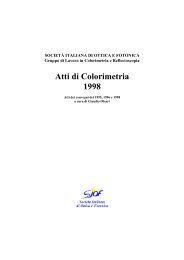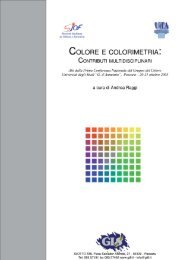Scarica gli atti - Gruppo del Colore
Scarica gli atti - Gruppo del Colore
Scarica gli atti - Gruppo del Colore
You also want an ePaper? Increase the reach of your titles
YUMPU automatically turns print PDFs into web optimized ePapers that Google loves.
espect to the unknown spectrum under the given illuminant and with the given<br />
observer, it may exhibit poor colorimetric matching with a different illuminant or<br />
observer, indicating that the underlying spectral match required has not been<br />
obtained. Since the spectral matching cannot be addressed directly, a method that<br />
allows the synthesis of a surface reflectance spectrum by taking into account<br />
colorimetric information referred to different illumination or observation<br />
conditions can increase the similarity between the estimated and the unknown<br />
reflectance spectrum.<br />
We have applied genetic algorithms to formulate the problem of reflectance<br />
estimation for the simultaneous optimization of several constraints. We have also<br />
investigated, in the framework of the proposed method, the performance of<br />
different basis sets for reflectance function representation.<br />
In Section 2 we provide a formal formulation of the problem addressed. Section 3<br />
describes the basis functions considered here, while Section 4 is a brief overview of<br />
the genetic algorithm proposed. The performance of the algorithm and of the basis<br />
functions is examined in Section 5, where standard datasets are used for<br />
benchmarking.<br />
2. Problem Formulation<br />
A color stimulus is related to the CIE XYZ tristimulus values by the following<br />
equations:<br />
∫<br />
X = K R(<br />
λ) I(<br />
λ)<br />
x(<br />
λ)<br />
dλ<br />
λ<br />
∫<br />
Y = K R(<br />
λ) I(<br />
λ)<br />
y(<br />
λ)<br />
dλ<br />
(1)<br />
λ<br />
∫<br />
Z = K R(<br />
λ) I(<br />
λ)<br />
z(<br />
λ)<br />
dλ<br />
λ<br />
where R(λ) is the reflectance spectrum, I(λ ) is the illuminant’s spectral power<br />
distribution, x (λ)<br />
, y (λ)<br />
and z (λ)<br />
are the color matching functions that define the<br />
CIE 1931 standard colorimetric observer. If the reflectance function is represented<br />
in the range of [0,1], and a luminance of 100 is attributed to the light source in the<br />
scene, then the normalization factor K is:<br />
K =<br />
∫<br />
λ<br />
100<br />
I(<br />
λ) y(<br />
λ)<br />
dλ<br />
Equation (1) indicates that an infinite number of different reflectance functions<br />
may generate the same tristimulus values. The reflectance function may be<br />
expressed through a linear mo<strong>del</strong> as a weighted sum of a set of basis functions:<br />
(2)<br />
149





